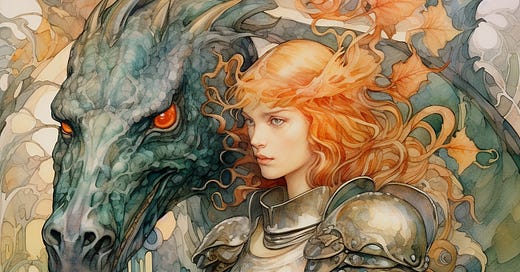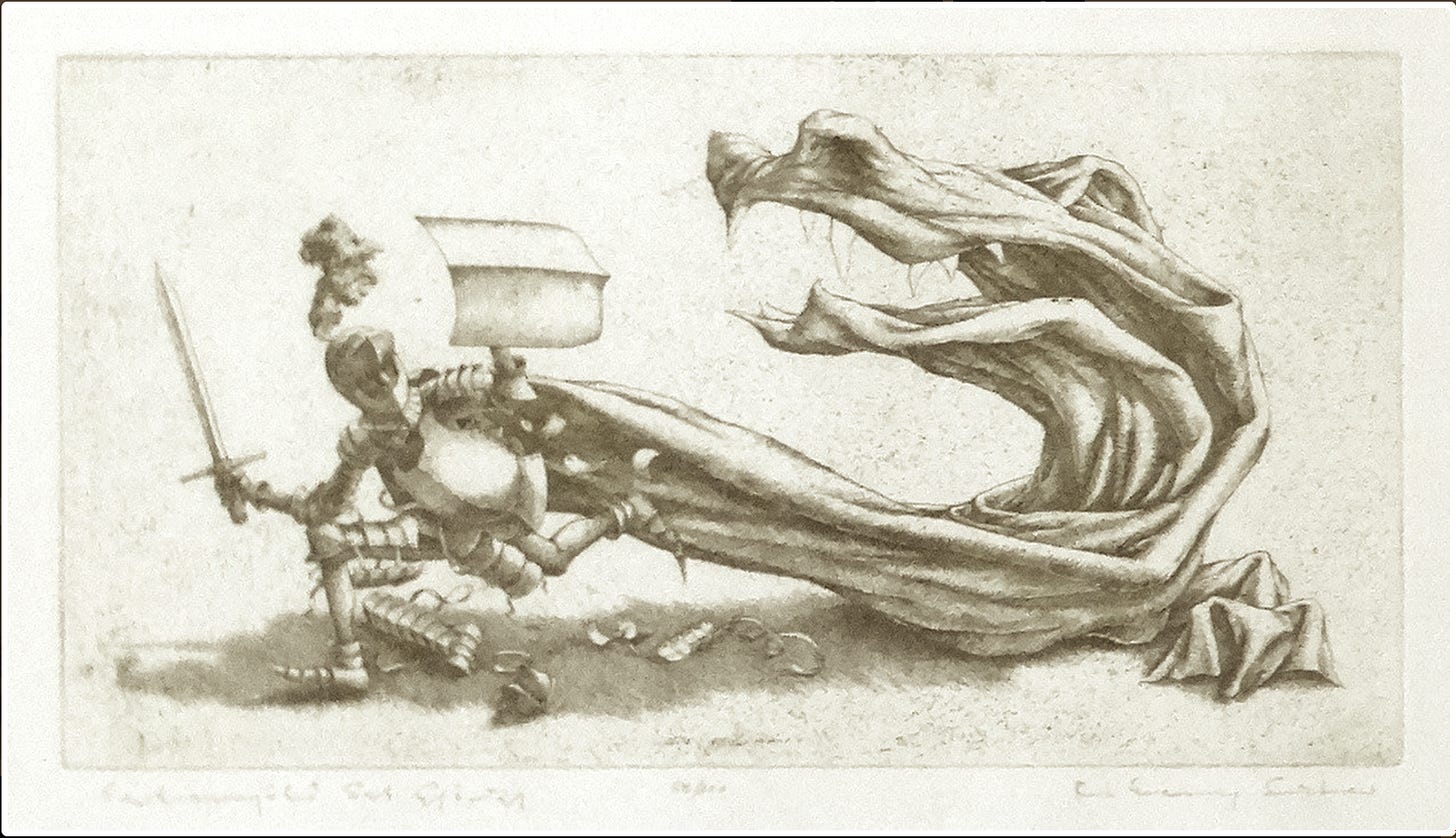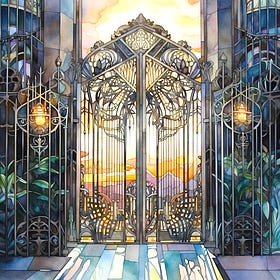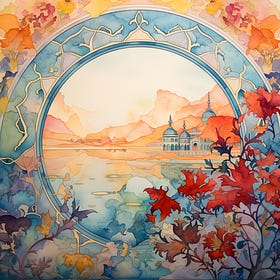Saint-Eszter and her dragons
Back in the day – about twenty years ago – when I was at university, one day a gallery held an exhibition in the hall. They brought etchings, which could even be purchased. As I already wrote in the article "Beauty Will Save the World," I love art and am tremendously inspired by it in all its forms. True to myself, I immediately bought several etchings. Of course, back then, in the absence of a credit card, I could only do so by paying the first installment of the purchase price and then paying the rest monthly by checks. I remember how proud I felt about a year and a half later when I paid back the loan I took out for the etchings. Among the purchased images, my favorite became the etching of Saint George Slaying the Dragon by Rékassy Eszter, a very talented Hungarian graphic artist. As soon as I saw it, I felt that the artist had managed to compress a truly profound truth into this frozen moment of battle.
Here is the etching in question:
This image has accompanied me everywhere since then and reminds me that often I am my own greatest enemy. I remember how many times I envisioned a complete apocalypse, anticipating future situations that never materialized, how many nights I spent in anxiety over a completely baseless conviction that this or that would happen, but in the end, everything resolved much more easily than I thought. Nowadays, when my husband hears me sketching out a possible apocalypse, he usually says that I should write to occupy my indeed overly active imagination with something sensible.
I also realized through the wisdom of folk tales and other magical stories that our dragon can be many things, but it is always some fear, attachment, or negative emotion of our ego that brings it to life. It's no coincidence that in "The Hobbit," Thorin Oakenshield struggles with the greedy Smaug, who, if we look at the story symbolically, had to defeat not the dragon but his own greed. Similarly, it's no accident that in various stories, dragons usually guard princesses, treasures, or the keys to solving challenges. To achieve the desired goal, win the princess’s hand, the vast treasure, half the kingdom, or the sword that can defeat the enemy, one somehow has to fight through the dragon. Many think of the dragon as some external power, but upon closer consideration, the heroes of these stories actually have to account for their own courage, insight, wisdom, composure, etc., when facing the dragon within. If they manage to defeat it, they pass the test and receive their reward.
That's why folk tales and stories like "The Hobbit" are so important, as they provide the subconscious, often not consciously grasped, patterns for defeating the inner dragon.
Our own dragon can be anything, and the more we engage with it, the stronger it becomes, the more power we give it over our lives. The dragon could be a longing so strong for a beautiful but currently unattainable car that it leaves us constantly feeling dissatisfied, thereby souring our lives. It might also be that we are so saddened because the one we love didn't choose us, that we can no longer appreciate the wonderful things in our lives, focusing only on our loss. Our dragon can be chronic, severe anxiety that prevents us from ever having a good night's sleep. It might also be bitterness or anger because we were passed over for a promotion in favor of a rival, causing us to literally breathe fire at our workplace. The dragon could even be an addiction that has taken over our lives. Drinking a glass or two of wine with dinner was still manageable, like Hagrid's dragon with eggshell still on its bottom, but when we start drinking one or two bottles a day, the dragon becomes as big as Smaug and is much harder to deal with.
The dragon can take a thousand forms, and often we only realize how much power we have given it when it has already grown strong and is severely poisoning our lives. If we want to defeat our dragon, we must arm ourselves with the unvarnished truth gained through introspection, and with self-awareness by sincerely examining our belief system. We need a cool head, achieved by healing and releasing our hurt feelings. Also we must keep in mind that it was us who raised the beast, who gave it energy and nourishment. And if it has grown strong through us, it is within our power to defeat it as well.
Over the past decades, I don't know how many dragons I have unwittingly nurtured, only to then struggle with them in bloody sweat. Dragons of anxiety, mistrust, fear of ostracism, loss, financial difficulties, creative blocks, timidity, anger, despair – to name just a few monsters. The battle was often bitter, frequently bloody, and there were one or two occasions when it was nearly fatal, but in the end, I emerged victorious.
Of course, dragons have always been there, are always there, and will always be there. Our ego never sleeps. The most we can do is try to recognize the beast while it is still small and weak and withdraw our attention from it. And if it's too late for that, then there's nothing left to do but roll up our sleeves, don our armor, take our sword in hand, confront it head-on and remind ourselves that we are actually fighting a monster that has taken shape from our own “cloak”.
Some dragons we don’t have to kill, but we tame them to be our helpers, supporting us by our side. Making the right decision on which dragon to slay and which to tame is real wisdom. Our true power lies in being able to transform and transmute pain and suffering into knowledge and wisdom, thereby fostering love for ourselves and the world.
If you would like to check out my armory, read the articles on Eszter’s Weekly Elephant!
– Eszter
Some links above are Amazon affiliate links, and if you buy something through these links I may earn a small commission at no extra cost to you.
Related
Beauty Will Save the World! – Why Was Dostoevsky Right?
The Cumulative Effect and How Delayed Judgement Helps Creative Endeavors
Home | Notes | Articles | Eszter’s Magic | Literary Bonbons | Short Stories and Guides | Beyond the Book | EWE Issues | Archive | About







